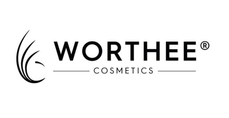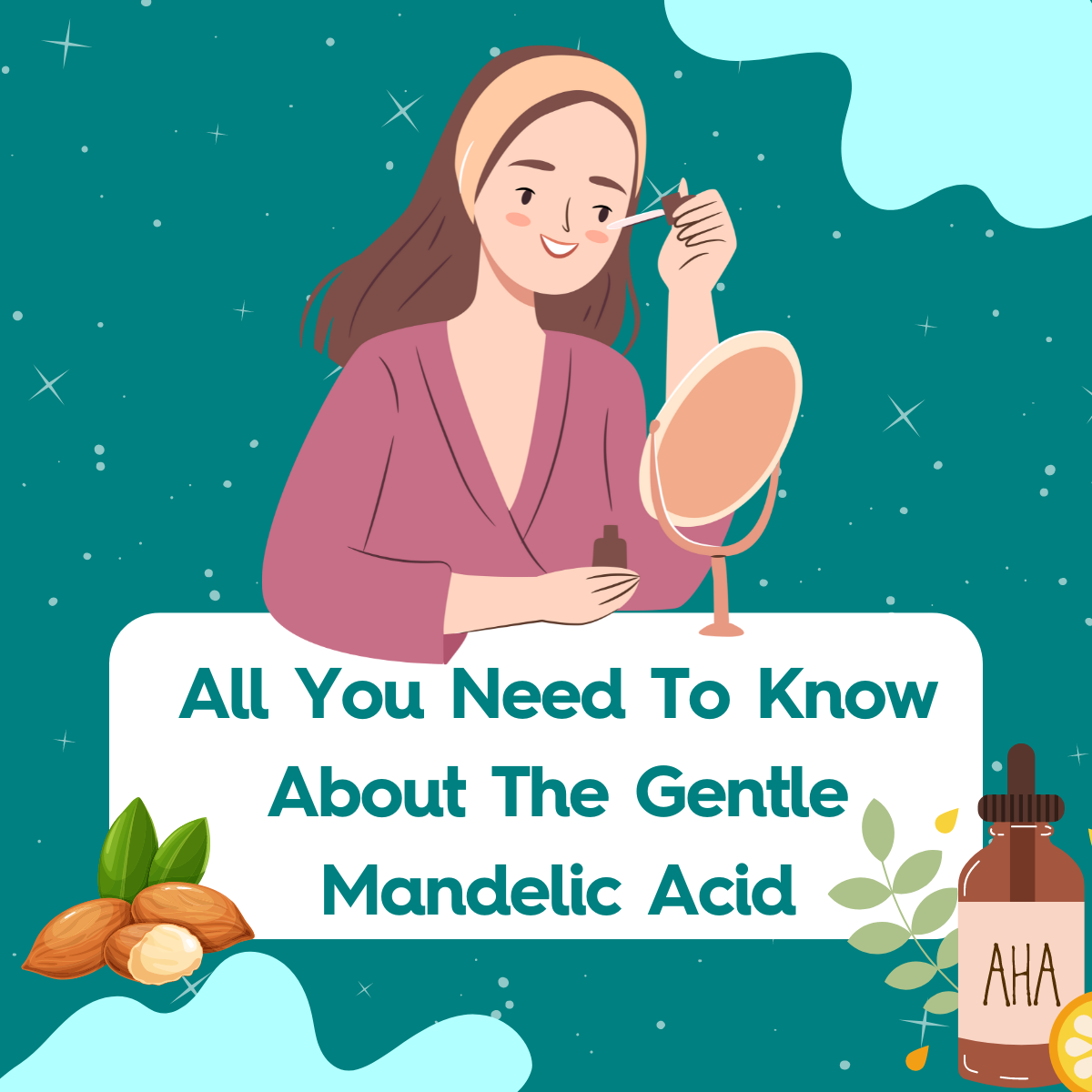Have you ever looked in the mirror and felt like your skin needs something else to cheer it up, though you had been applying your skincare religiously? In the past, you might grab any face scrub you have in your collection, expecting it to eliminate the dullness-causing dead skin cells.
Now, as the beauty trend evolves, chemical exfoliants join our beauty routine – AHAs, BHA and PHAs, which are less invasive versions of what we used to call “harsh scrubs”. In this article, we shine the spotlight on a recent AHA star – Mandelic Acid.
The Origins of Mandelic Acid

Mandelic Acid (MA) is one of the family members of AHAs. Derived naturally from the hydrolysis of bitter almond extracts, it is named after the word “Mandel” which means “almond” in German. It can also be derived synthetically through the preparation of the acid-catalysed hydrolysis of Mandelonitrile.

Just like any other AHAs, Mandelic Acid would penetrate the skin to unhook the bonds that clutch dead cells on the surface of the skin, allowing them to shed effectively. So, what makes it different from other AHAs?
The Best Concentrations of Mandelic Acid and the Benefits
Being the humblest family member of AHAs, Mandelic Acid is gentler on the skin as it penetrates slowly and uniformly, due to its large molecular weight (152.1 g/mol vs Glycolic Acid at 76.05 g/mol). Hence, it could hardly cause skin irritation and it is usually recommended for sensitive skin.Even if it is clarified as the gentlest on the skin, please do not straight away go with the highest concentration of this ingredient. Instead, always introduce any acidic ingredients at the lowest concentration first before you go big. So, which concentration is the best for you?
- For Beginners
The concentration of 2% -10% concentration of MA would be sufficient for a start. It could help you prevent dullness, the roughness of the skin, and clogged pores. A study in 2015 proved that both 5% and 10% MA treat acne effectively without unfavorable side effects.
- For Experienced Acid Users
If your skin is already familiar with acids, there are over-the-counter MA formulations up to 30% in the market. Firstly, identify if you truly have the need to go for this strength. We typically recommend high-strength acids to those with stubborn skin concerns unresolved by moderate-strength exfoliants. Though we mentioned that the MA molecule itself is a gentler AHA compared to the other AHA family members. But, when MA is at 30%, it is absolutely not more gentle than a 5% Glycolic/Lactic Acid. Follow the product’s instructions strictly if you are using a high-strength MA exfoliant, to avoid unwanted irritation.
- Special Treatments
If you are going through cystic acne and melasma, you can try Mandelic Acid with concentrations of 30% and above, but of course, it must be under the supervision of a dermatologist. If utilized safely, as shown in a 2013 study, 40% of MA contributes to an increase in sebum secretion in ageing women and hence, reduces the effects of the ageing process.

s
The Best Mandelic Acid Formulas
Striving to serve only the best to you, we have our standards in selecting the best products with Mandelic Acid for you. First and foremost, We do not recommend MA dissolved in a high concentration of alcohol to avoid magnified irritation.
Similar to Salicylic Acid (BHA), the pH range of 3.0-4.0 is documented to be skin safe. As for the consistency, Mandelic Acid in the form of liquid is meant for all skin types while the gel is suitable for combination-oily skin and for very dry skin, lotion texture would be the best option for you.
The Recommended Mandelic Acid Exfoliants
Geek & Gorgeous Cheer up 6% Mandelic Acid + BHA Liquid is a moderate-strength, holistic exfoliant that targets both the skin’s roughing surface and within your pores, for an in-depth yet gentle exfoliation. Cleverly combining 5% Mandelic Acid and 1% oil-soluble Salicylic Acid (BHA) and Sarcosine at a perfect concentration, this defeats pore-related concerns and breaks down blemish-arising clogged sebum.
We love to call this a toning exfoliant. With its water-light texture, using it as the first step after cleansing preps skin for more actives layering thereafter. Gentle enough for daily use. The results? Soft-to-the-touch skin with fresh, true radiance.

If the liquid-textured product is not your cup of tea, the gel-based The Ordinary Mandelic Acid 10% + HA is a non-abrasive, leave-on exfoliating serum that revitalizes the skin’s surface, smooth fine lines, creates visible brightness and helps your skin stay impressively soft. The addition of Hyaluronic Acid helps hydrate dryness. This is ideal for all skin types and a good option for those with sensitive skin.

Chemist Confessions the Specialist: AHA + BHA + Niacinamide Treatment for Intermediate Acid Users contains 18% of Mandelic Acid, a higher concentration that allows you to truly experience the exfoliating power and gentleness of MA. While MA exfoliates the top layer of skin, even better, the existence of Salicylic Acid oil-soluble cares for the pore linings to address the many systemic pore-related problems. The smart combo of water and oil soluble medley of AHA and BHA reactivate skin’s youthful mechanisms as well as addresses the root cause of acne and congested pores.
Even better, the addition of 5% Niacinamide + Willow Herb Flower/Leaf Extract + Sweet Potato Root Extract strengthen the skin surface and offset environmental assaults. This state-of-the-art product is ideal for all skin types, particularly for combination skin types or very oily skin struggling with pore-related concerns.

If you wish to try a rinse-off MA exfoliant, Bffect AHA 30% + Mandelic Acid 4% Peeling Solution is for you. In just 10 minutes, this significantly transforms textural irregularities, unevenness and blemishes. Coupled with anti-inflammatory and soothing plant extracts, this exfoliates gently yet intensively, leading to smaller pores, brighter complexion with lesser dark spots and smoother skin texture with reduced fine lines and wrinkles.
Due to the high concentration of 30% AHA and another addition of 4% Mandelic Acid, this potent blend is strictly for experienced AHA users who need an intensive exfoliating treatment to target stubborn blemishes, discoloration and ageing-related concerns.

Have you tried Mandelic Acid before? Share with us your thoughts about this amazing ingredient!
References
- Dębowska, R. M., Kaszuba, A., Michalak, I., Dzwigałowska, A., Cieścińska, C., Jakimiuk, E., Zielińska, J., & Kaszuba, A. (2015). Evaluation of the efficacy and tolerability of mandelic acid-containing cosmetic formulations for Acne Skin Care. Dermatology Review, 4, 316–321. https://doi.org/10.5114/dr.2015.53419
- Enrico, G., Lucia, F.A., & Roberto, P. (2019). Dermabrasion with Non-Ablative Electrosurgery and Peeling with Mandelic Acid and Lactoferrin In the Treatment of Perioral Wrinkles. Dermatology Research.
- Garg, V. K., Sinha, S., & Sarkar, R. (2009). Glycolic acid peels versus salicylic-mandelic acid peels in active acne vulgaris and post-acne scarring and hyperpigmentation: a comparative study. Dermatologic surgery : official publication for American Society for Dermatologic Surgery [et al.], 35(1), 59–65. https://doi.org/10.1111/j.1524-4725.2008.34383.x
- Jacobs, S. W., & Culbertson, E. J. (2018). Effects of Topical Mandelic Acid Treatment on Facial Skin Viscoelasticity. Facial plastic surgery : FPS, 34(6), 651–656. https://doi.org/10.1055/s-0038-1676048
- National Center for Biotechnology Information (2022). PubChem Compound Summary for CID 1292, Mandelic acid. Retrieved September 14, 2022 from https://pubchem.ncbi.nlm.nih.gov/compound/Mandelic-acid.
- Rizza, L., Frasca, G., Bonina, C., & Puglia, C. (2010). Comparative in vivo study of the efficacy and tolerance of exfoliating agents using reflectance spectrophotometric methods. Journal of cosmetic science, 61(3), 247–258.
- Taylor, M. B. (1999). Summary of Mandelic Acid for the Improvement of Skin Conditions. Cosmetic Dermatology, 26–28. https://nucelle.com/wp-content/uploads/2019/12/MandelicAcid-Efficacy.pdf
- Wójcik, A., Kubiak, M., & Rotsztejn, H. (2013). Influence of azelaic and mandelic acid peels on sebum secretion in ageing women. Postepy dermatologii i alergologii, 30(3), 140–145. https://doi.org/10.5114/pdia.2013.35614


